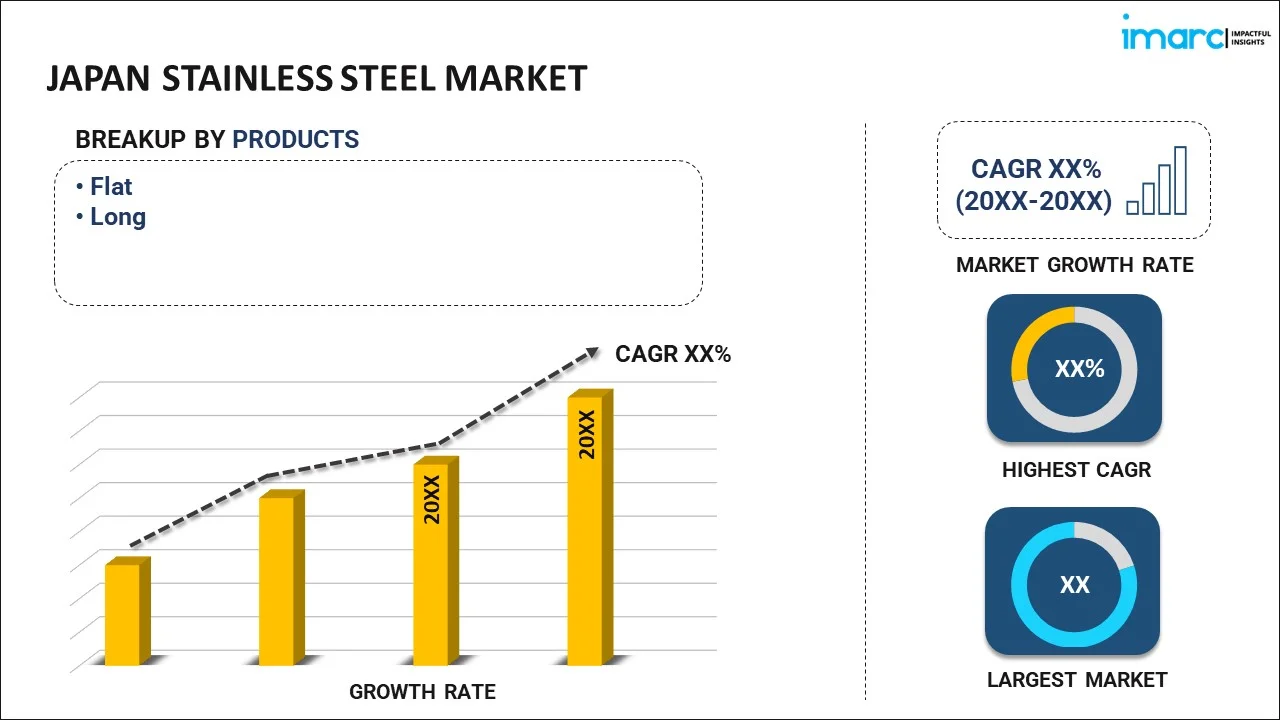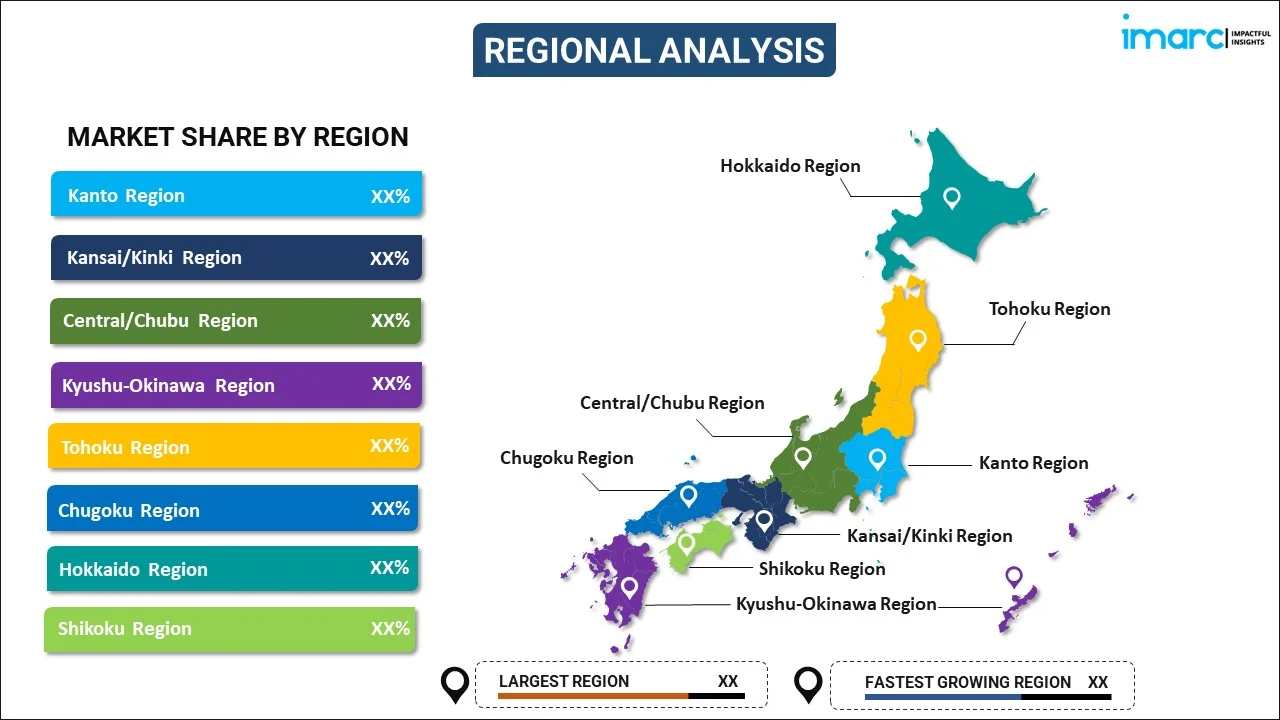
Japan Stainless Steel Market Report by Product (Flat, Long), Grade (200 Series, 300 Series, 400 Series, Duplex Series, and Others), Application (Automotive and Transportation, Building and Construction, Consumer Goods, Mechanical Engineering and Heavy, Industries, and Others), and Region 2025-2033
Market Overview:
Japan stainless steel market size reached 1.4 Million Tons in 2024. Looking forward, IMARC Group expects the market to reach 1.9 Million Tons by 2033, exhibiting a growth rate (CAGR) of 3.5% during 2025-2033. The increasing prevalence of infrastructure projects, such as the construction of bridges, highways, airports, and public buildings, which often require large quantities of stainless steel for their durability and resistance to corrosion, is primarily driving the market.
|
Report Attribute
|
Key Statistics
|
|---|---|
|
Base Year
|
2024
|
|
Forecast Years
|
2025-2033
|
|
Historical Years
|
2019-2024
|
| Market Size in 2024 | 1.4 Million Tons |
| Market Forecast in 2033 | 1.9 Million Tons |
| Market Growth Rate 2025-2033 | 3.5% |
Stainless steel is a versatile and corrosion-resistant alloy composed primarily of iron, chromium, nickel, and other elements. Its exceptional durability and resistance to rust and staining make it a popular choice in various industries, including construction, automotive, aerospace, and kitchenware. The key to stainless steel's corrosion resistance lies in the formation of a thin, protective oxide layer on its surface, which prevents further deterioration when exposed to moisture or harsh environments. This property makes it suitable for outdoor applications, marine environments, and exposure to acidic substances. Stainless steel comes in various grades, each tailored to specific applications. For instance, austenitic stainless steel, containing high levels of nickel and chromium, is non-magnetic and exceptionally resistant to corrosion, making it ideal for food processing and medical equipment. Ferritic and martensitic stainless steels, on the other hand, are magnetic and often used in automotive exhaust systems and cutlery due to their strength and heat resistance. In summary, stainless steel's unique blend of strength, corrosion resistance, and aesthetic appeal makes it a fundamental material in modern industry and everyday life.
Japan Stainless Steel Market Trends:
The stainless steel market in Japan continues to dominate various industries due to several compelling drivers. Firstly, its versatility makes it indispensable across sectors from construction to healthcare. Secondly, the regional surge in infrastructure development fuels stainless steel demand, as it offers structural integrity and aesthetics. Moreover, the automotive industry's shift toward lightweight materials to enhance fuel efficiency and reduce emissions bolsters stainless steel's usage in-vehicle components. Furthermore, the increasing emphasis on sustainable practices propels the stainless steel market, as it is fully recyclable and has a long lifecycle, minimizing environmental impact. Additionally, the booming oil and gas sector relies on stainless steel for pipelines and equipment to withstand harsh conditions, further boosting demand. The pharmaceutical and food processing industries prioritize stainless steel for its hygiene and safety attributes, fostering consistent growth. Lastly, the burgeoning demand for consumer electronics, kitchen appliances, and healthcare equipment is expected to drive the stainless steel market in Japan during the forecast period.
Japan Stainless Steel Market Segmentation:
IMARC Group provides an analysis of the key trends in each segment of the market, along with forecasts at the country level for 2025-2033. Our report has categorized the market based on product, grade, and application.
Product Insights:

- Flat
- Long
The report has provided a detailed breakup and analysis of the market based on the product. This includes flat and long.
Grade Insights:
- 200 Series
- 300 Series
- 400 Series
- Duplex Series
- Others
A detailed breakup and analysis of the market based on the grade have also been provided in the report. This includes 200 series, 300 series, 400 series, duplex series, and others.
Application Insights:
- Automotive and Transportation
- Building and Construction
- Consumer Goods
- Mechanical Engineering and Heavy Industries
- Others
The report has provided a detailed breakup and analysis of the market based on the application. This includes automotive and transportation, building and construction, consumer goods, mechanical engineering and heavy industries, and others.
Regional Insights:

- Kanto Region
- Kansai/Kinki Region
- Central/ Chubu Region
- Kyushu-Okinawa Region
- Tohoku Region
- Chugoku Region
- Hokkaido Region
- Shikoku Region
The report has also provided a comprehensive analysis of all the major regional markets, which include Kanto Region, Kansai/Kinki Region, Central/ Chubu Region, Kyushu-Okinawa Region, Tohoku Region, Chugoku Region, Hokkaido Region, and Shikoku Region.
Competitive Landscape:
The market research report has also provided a comprehensive analysis of the competitive landscape. Competitive analysis such as market structure, key player positioning, top winning strategies, competitive dashboard, and company evaluation quadrant has been covered in the report. Also, detailed profiles of all major companies have been provided.
Japan Stainless Steel Market Report Coverage:
| Report Features | Details |
|---|---|
| Base Year of the Analysis | 2024 |
| Historical Period | 2019-2024 |
| Forecast Period | 2025-2033 |
| Units | Million Tons |
| Scope of the Report | Exploration of Historical Trends and Market Outlook, Industry Catalysts and Challenges, Segment-Wise Historical and Future Market Assessment:
|
| Products Covered | Flat, Long |
| Grades Covered | 200 Series, 300 Series, 400 Series, Duplex Series, Others |
| Applications Covered | Automotive and Transportation, Building and Construction, Consumer Goods, Mechanical Engineering and Heavy, Industries, Others |
| Regions Covered | Kanto Region, Kansai/Kinki Region, Central/ Chubu Region, Kyushu-Okinawa Region, Tohoku Region, Chugoku Region, Hokkaido Region, Shikoku Region |
| Customization Scope | 10% Free Customization |
| Post-Sale Analyst Support | 10-12 Weeks |
| Delivery Format | PDF and Excel through Email (We can also provide the editable version of the report in PPT/Word format on special request) |
Key Questions Answered in This Report:
- How has the Japan stainless steel market performed so far and how will it perform in the coming years?
- What has been the impact of COVID-19 on the Japan stainless steel market?
- What is the breakup of the Japan stainless steel market on the basis of product?
- What is the breakup of the Japan stainless steel market on the basis of grade?
- What is the breakup of the Japan stainless steel market on the basis of application?
- What are the various stages in the value chain of the Japan stainless steel market?
- What are the key driving factors and challenges in the Japan stainless steel market?
- What is the structure of the Japan stainless steel market and who are the key players?
- What is the degree of competition in the Japan stainless steel market?
Key Benefits for Stakeholders:
- IMARC’s industry report offers a comprehensive quantitative analysis of various market segments, historical and current market trends, market forecasts, and dynamics of the Japan stainless steel market from 2019-2033.
- The research report provides the latest information on the market drivers, challenges, and opportunities in the Japan stainless steel market.
- Porter's five forces analysis assist stakeholders in assessing the impact of new entrants, competitive rivalry, supplier power, buyer power, and the threat of substitution. It helps stakeholders to analyze the level of competition within the Japan stainless steel market industry and its attractiveness.
- Competitive landscape allows stakeholders to understand their competitive environment and provides an insight into the current positions of key players in the market.
Need more help?
- Speak to our experienced analysts for insights on the current market scenarios.
- Include additional segments and countries to customize the report as per your requirement.
- Gain an unparalleled competitive advantage in your domain by understanding how to utilize the report and positively impacting your operations and revenue.
- For further assistance, please connect with our analysts.
 Inquire Before Buying
Inquire Before Buying
 Speak to an Analyst
Speak to an Analyst
 Request Brochure
Request Brochure
 Request Customization
Request Customization




.webp)




.webp)












